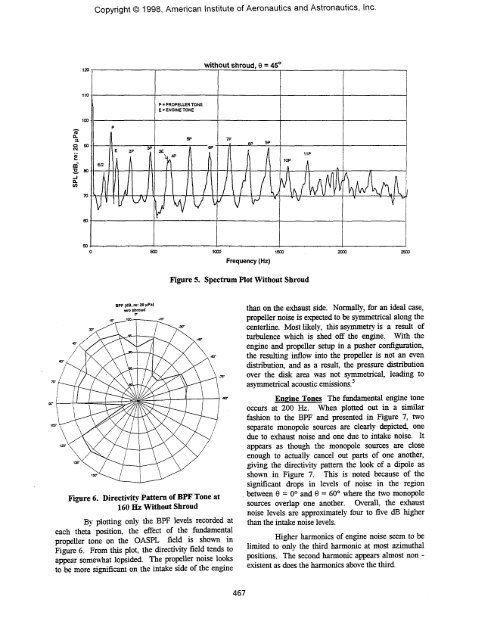tobe moreCopyright© 1998, American Institute of Aeronautics and Astronautics, Inc.expected<strong>with</strong>out shroud, 6=45°1000 1500Frequency (Hz)Figure 5. SpectrumPlot Without ShroudBPF (dB, re:20 |iPa)w/o shroudFigure 6. Directivity Pattern of BPF Tone at160 Hz Without ShroudBy plotting only theBPF levels recorded ateach theta position, the effect of the fundamental<strong>propeller</strong> tone on the OASPL field is shown inFigure 6. From this plot, the directivity field tends toappear somewhat lopsided. The <strong>propeller</strong> <strong>noise</strong> lookssignificant onthe intake side ofthe enginethan onthe exhaust side. Normally, foran ideal case,<strong>propeller</strong> <strong>noise</strong> is tobe symmetrical along thecenterline. Most likely, this asymmetry is a result ofturbulence which is shed off the engine. With theengine and <strong>propeller</strong> setup ina pusher configuration,the resulting inflow into the <strong>propeller</strong> is not an evendistribution, and as a result, the pressure distributionover the disk area was not symmetrical, leading toasymmetrical acoustic emissions. 3Engine Tones The fundamental engine toneoccurs at 200 Hz. When plotted out in a similarfashion totheBPFand presented in Figure 7, twoseparate monopole sources are clearly depicted, onedue to exhaust <strong>noise</strong> and one due to intake <strong>noise</strong>. Itappears as though the monopole sources are closeenough to actually cancel out parts of one another,giving the directivity pattern the look ofa dipole asshown in Figure 7. This is noted because of thesignificant drops in levels of <strong>noise</strong> in the regionbetween 9 = 0° and 6 = 60° where the two monopolesources overlap one another.<strong>noise</strong> levels are approximately four to fivethan the intake <strong>noise</strong> levels.Overall, the exhaustdB higherHigher harmonics of engine <strong>noise</strong> seem to belimited to only the third harmonic at most azimuthalpositions. The second harmonic appears almost non -existent as does the harmonics above the third.467
the1/8ofanCopyright© 1998, American Institute of Aeronautics and Astronautics, Inc.respectively.increasethistheyhavecurvesEngine Noise (dB, re:orJ96(90° < 9 < 150°) the levels of <strong>noise</strong> appear fairlyconstant, (<strong>with</strong>in 2 dB's) indicating no distinct lobe atthis position. This isin contrast tothe unshrouded<strong>propeller</strong> which appears to a distinct lobe at thislocation ascanbe seen by comparing the inFigure 4and8.help to determineMeasurements beyond 150° wouldisthe case.ifOASPL (dB, re:<strong>with</strong> shroudFigure 7. Directivity Pattern of EngineTone at 200 HzNoise With ShroudThe same measurements previously discussedwere taken <strong>with</strong> the shroud in place. Of primaryinterest wasthe OASPL measurements which provideda direct comparison tothe unshrouded configuration.Also of importance were the power spectra, whichproved tobe most insightful when analyzing thepropulsion system <strong>noise</strong> <strong>with</strong> the shroud in place.With the <strong>propeller</strong> blades passing <strong>with</strong>in about one halfan inch behind the trailing edge of the stator vanes, itwas assumed that strong interaction tones would beobserved between the <strong>propeller</strong> and stators. In fact,this was the case. Other factors thought to influenceoverall <strong>noise</strong> included shroud shielding, ductacoustical emissions, andan in <strong>propeller</strong>efficiency due to a reduction in tip vortices. The gapbetween <strong>propeller</strong> tipand shroud was approximatelyinch.OASPL Measurements The directivitypattern of the OASPL <strong>with</strong> the shroud follows the sametrends asthe unshrouded case, although an increase inlevels is evident. Increases in higher harmonicsamount to approximately asix decibel increase intheoverall sound pressure level. Upon examination of thedirectionality field in Figure 8 maximum OASPL's areobserved at both 9=45°and9= -45° than <strong>with</strong> valuesof 110.1 dBand 111.3 dB, This variesonly slightly from the pattern noted <strong>with</strong>out the shroud,as a slightly higher <strong>noise</strong> level is seen around 9 = -45°<strong>with</strong> the shroud. Behind the plane of rotation,Figure 8. Measured Directivity PatternWith Shroud in PlaceRotor-Stator Interaction Tones Powerspectralanalysis scans were performed in the samemanner as for the unshrouded configuration. Again,all tones fall under one of two types: either rotor -stator interaction <strong>noise</strong> or engine <strong>noise</strong>, except foroneunidentified tone at 520 Hz which appears in all thefrequency scans <strong>with</strong> the shroud in place.From examination ofthepower spectrumpresented in Figure 9, the increase in OASPL canbeattributed mostly to a set of distinct tones that occur atintervals of 160 Hz and higher. Notice that the tonesappear at the same frequencies as the BPF and itscorresponding harmonics, however, these tones areattributed more to<strong>propeller</strong> harmonics.rotor-stator interactions than theUnlike theBPFand associated <strong>propeller</strong>harmonics, the fundamental rotor-stator interactiontone does not appear as the most significant tone.Instead, the highest level in the spectrum appears ataround the4thor5th interval tone, and instead ofthehigher tones diminishing as increase in frequency,they remain at fairly constant levels until a frequency468
















